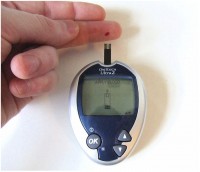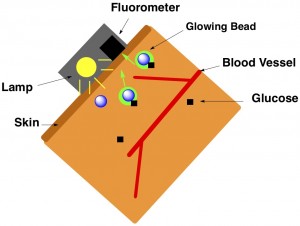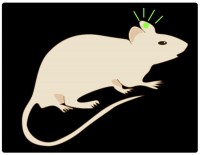New technology could allow for continuous blood glucose monitoring by checking if a patch of your skin is glowing or not. A paper published in PNASProceedings of the National Academy of Sciences this week describes a development that sounds like a crazy idea… so crazy that it just might work?
Because of the huge number of people affected by diabetes, it is no surprise that massive amounts of research efforts are directed at improving treatment options. For a person living with diabetes, it is vitally important to monitor and regulate blood glucose'sugar' levels, as prolonged abnormal glucose levels lead to a plethora of complications affecting the heart, kidneys, eyes, etc. The most common way to monitor glucose levels is by a pinprick blood test, taken daily or several times per day. Though useful, these tests don’t allow one to have continuous monitoring of glucose levels, and it is easy to miss major fluctuations during the day or at night. Furthermore, it’s a nuisance to prick your finger every day with a needle, and people have a tendency to procrastinate or forget about testing their glucose levels.

Continuous glucose monitoring systems do exist, but they aren’t intended for long term use. Devices in development for long-term monitoring will require surgical implantation, or insertion with a large-bore needle. The idea put forth in this paper has potential to offer a more pleasant solution for continuous glucose monitoring. The authors developed tiny microbeads, about 100 micrometersabout the diameter of a thin hair in diameter, that glow when they are exposed to glucose. In theory, these beads could be injected just under the skin using a normal-sized needle. At high levels of glucose, the beads would glow brightly, and at low levels of glucose they wouldn’t glow at all. Presumably, a small external device on top of the skin, above the site of the glowing beads, could quantitatively measure how brightly they glow.

The microbeads are made of a solid polymer (kind of like a plastic), with glucose-sensing molecules attached. When glucose is around, these sensing molecules bind to it. This binding causes a change in the way different parts of the molecule interact with each other, and the result is that one part of the molecule becomes capable of emitting light.
 People have played around with this idea for the last few years, but the problem has been designing a sensor that can emit a bright enough light that you could see it through a few layers of skin. The authors of this paper, however, demonstrated that these beads glow brightly enough to see them when they are implanted under the skin of a mouse ear.
People have played around with this idea for the last few years, but the problem has been designing a sensor that can emit a bright enough light that you could see it through a few layers of skin. The authors of this paper, however, demonstrated that these beads glow brightly enough to see them when they are implanted under the skin of a mouse ear.
 The fluorescence of these little beads is similar to the glow-in-the-dark stars that you could stick on your ceiling if you were a kid during the 90s. They don’t exactly glow in the dark – you first have to leave the lights on in the room for a little bit. It’s almost like they soak up the light. Then, when you switch the lights off, they glow. Similarly, when these microbeads sense glucose, they become capable of acting like glow-in-the-dark stars. If you quickly shine a light on them, and then turn the light off, they’ll glow. The intensity of this glow can be quantitatively measured by a fluorometer (a light-measuring device) that spits out a numerical value for the light intensity. This value will be higher if there’s more glucose around, and lower if there’s less glucose around.
The fluorescence of these little beads is similar to the glow-in-the-dark stars that you could stick on your ceiling if you were a kid during the 90s. They don’t exactly glow in the dark – you first have to leave the lights on in the room for a little bit. It’s almost like they soak up the light. Then, when you switch the lights off, they glow. Similarly, when these microbeads sense glucose, they become capable of acting like glow-in-the-dark stars. If you quickly shine a light on them, and then turn the light off, they’ll glow. The intensity of this glow can be quantitatively measured by a fluorometer (a light-measuring device) that spits out a numerical value for the light intensity. This value will be higher if there’s more glucose around, and lower if there’s less glucose around.
These beads are more specialized than glow-in-the-dark stars. They need to have a specific wavelength of light shined on them, and if you shine a light on them for very long they get worn out and stop glowing. Thus, a glucose measuring device based on this concept would have to include a tiny lamp of the right wavelength that would intermittently flash a light onto your skin, then shut off and measure the amount of light that shined back out of your skin.
A device built on these glowing microbeads is probably a long way off, but it’s kind of a cool (though a little weird) concept.
Update: Sciencegeist talks about another weird/cool glucose-monitoring approach that’s in the works, involving Raman spectroscopy.


Pingback: Scientia Pro Publica 43: Loving, Living, Learning « Traversing the Razor